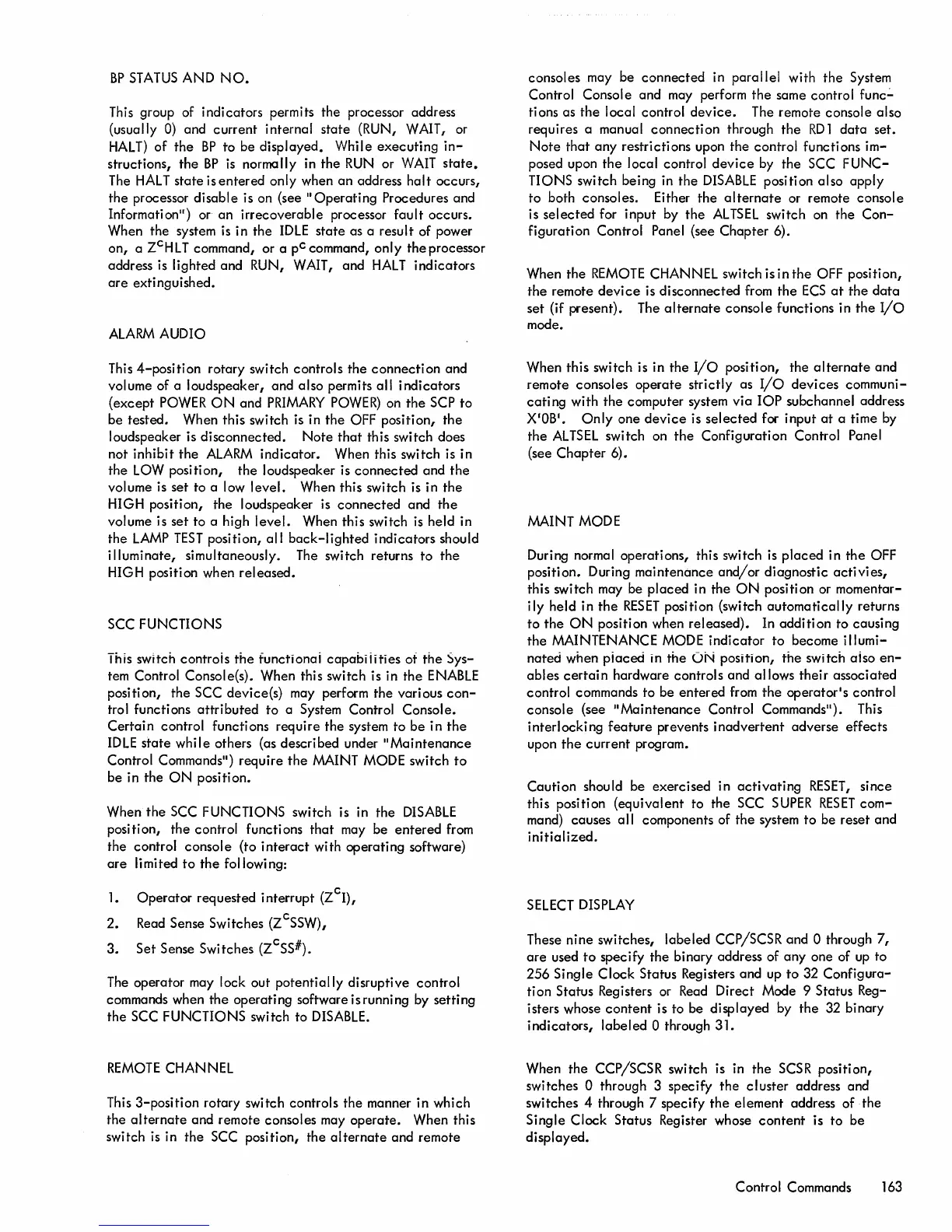BP
STATUS
AND
NO.
Th
i s group of i ndi cators perm i ts the processor address
(usually
0)
and
current
internal
state
(RUN, WAIT, or
HALT)
of
the
BP
to be
displayed.
While
executing
in-
structions,
the
BP
is
normally in
the
RUN
or
WAIT
state.
The
HALT
state
is
entered
only when
an
address
halt
occurs,
the
processor
disable
is on (see
II
Operating
Procedures and
Information
lr
) or
an
irrecoverable
processor
fault
occurs.
When the system is
in
the
IDLE
state
as a result of power
on, a
ZCHLT
command, or a pc command,
only
the
processor
address is lighted
and
RUN, WAIT,
and
HALT
indicators
are
extinguished.
ALARM
AUDIO
This
4-position
rotary switch controls
the
connection
and
volume of a loudspeaker,
and
also
permits all
indicators
(except
POWER
ON
and
PRIMARY
POWER)
on
the
SCP
to
be
tested.
When this switch is in
the
OFF
position,
the
loudspeaker is
disconnected.
Note
that
this switch does
not
inhibit
the
ALARM
indicator.
When this switch is
in
the
LOW position,
the
loudspeaker is
connected
and
the
volume is
set
to a low
level.
When this switch is in
the
HIGH position,
the
loudspeaker is
connected
and
the
volume is
set
to a high
level.
When this switch
is
held in
the
LAMP
TEST
position,
all
back-lighted
indicators
should
illuminate,
simultaneously. The switch returns
to
the
HIGH position when
released.
SCC FUNCTIONS
This sWitch
controis
the
functionai
capabiiities
of
the
Sys-
tem Control Console(s). When this switch is in
the
ENABLE
position,
the
SCC device(s) may perform
the
various
con-
trol functions
attributed
to
a System Control Console.
Certain
control functions
require
the
system
to
be
in
the
IDLE
state
while
others (as described under
"Maintenance
Control Commands")
require
the
MAINT MODE switch
to
be in
the
ON
position.
When
the
SCC FUNCTIONS switch is in
the
DISABLE
position,
the
control functions
that
may be
entered
from
the
control
console
(to
interact
with
operating
software)
are
limited
to
the
following:
1.
Operator
requested
interrupt
(Zc
I
),
2.
Read Sense Switches
(Zc
SSW
),
3.
Set
Sense Switches (Zc
SS
#).
The operator may lock out
potentially
disruptive control
commands when
the
operating
software
isrunning
by
setting
the
SCC FUNCTIONS switch to
DISABLE.
REMOTE
CHANNEL
This
3-position
rotary switch controls
the
manner
in
which
the
alternate
and
remote consoles may
operate.
When this
switch is in
the
SCC position,
the
alternate
and
remote
consoles may be
connected
in
parallel
with
the
System
Control Console
and
may perform
the
same control
func':"
tions as
the
local control
device.
The remote
console
also
requires a manual
connection
through
the
RD1
data
set.
Note
that
any
restrictions upon
the
control functions
im-
posed upon
the
local
control
device
by
the
SCC
FUNC-
TIONS
switch being in
the
DISABLE
position
also
apply
to
both consoles. Either
the
alternate
or remote
console
is
selected
for
input
by
the
AL
TSEL
switch on
the
Con-
figuration
Control Panel (see
Chapter
6).
When
the
REMOTE
CHANNEL switch is in
the
OFF position,
the
remote
device
is
disconnected
from
the
ECS
at
the
data
set
(if present). The
alternate
console
functions in
the
I/o
mode.
When
this
switch is in
the
I/o
position,
the
alternate
and
remote consoles
operate
strictly
as
I/O
devices
communi-
cating
with
the
computer system
via
lOP
subchannel address
X'OB'.
Only
one
device
is
selected
for
input
at
a time by
the
ALTSEL
switch on
the
Configuration
Control Panel
(see
Chapter
6).
MAINT
MODE
During normal
operations,
this switch is
placed
in
the
OFF
position. During
maintenance
and/or
diagnostic
activies,
this switch may be
placed
in
the
ON
position or momentar-
i
Iy
held
in
the
RESET
position (switch
automatically
returns
to
the
ON
position when
released).
In
addition
to
causing
the
MAINTENANCE MODE
indicator
to
become
illumi-
nated
when
piaced
in
the
ON
position,
the
sWitch
aiso
en-
ables
certain
hardware controls
and
allows
their
associated
control commands
to
be
entered
from
the
operator's
control
console
(see
"Maintenance
Control Commands"). This
interlocking
feature
prevents
inadvertent
adverse
effects
upon
the
current
program.
Caution
should
be
exercised
in
activating
RESET,
since
this position
(equivalent
to
the
SCC
SUPER
RESET
com-
mand) causes
all
components of
the
system
to
be
reset
and
initialized.
SELECT
DISPLAY
These
nine
switches,
labeled
CCP/SCSR
and
0 through
7,
are
used
to
specify
the
binary address of
anyone
of
up
to
256
Single
Clock
Status Registers
and
up
to
32
Configura-
tion
Status
Registers or Read Direct Mode 9 Status Reg-
isters whose
content
is to be
displayed
by
the
32 binary
indicators,
labeled
0 through
31.
When
the
CCP/SCSR switch is in
the
SCSR
position,
switches 0 through 3 specify
the
cluster
address and
switches 4 through 7 specify
the
element
address of
the
Single
Clock
Status
Register whose
content
is
to
be
displayed.
Control Commands 163

